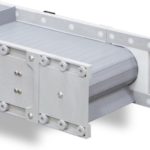 Conveyor tracking problems are an unexpected maintenance issue that requires the conveyor system to be shut down, which in turn reduces or stops production. The cost of lost production has an immediate impact on profitability and increases your total cost of ownership.
Conveyor tracking problems are an unexpected maintenance issue that requires the conveyor system to be shut down, which in turn reduces or stops production. The cost of lost production has an immediate impact on profitability and increases your total cost of ownership.
One of leading reasons for conveyor maintenance is conveyor belt tracking problems. Conveyor tracking problems can be identified when the belt wanders to the left or right instead of going straight down the center of the conveyor. Significant damage to the belt and/or conveyor frame will be the result if this condition is not corrected promptly, only adding to production downtime. Conveyor belt tracking issues happen exclusively to belts that need to be tensioned (stretched) in order for the friction drive pulley to pull the conveyor belt. Over or under tensioning the tail pulley, misalignment, non-level floors and non-uniform product loading all induce tracking issues. The tracking issue is enhanced whenever the conveyor has inclination changes (going from horizontal to inclined).
The only way to permanently eliminate all conveyor belt tracking problems is to switch to a conveyor that does not require the belt to be under tension in order to operate. Sprocket driven belts operate by positively inserting teeth into the belt in order to drive the belt. As it moves towards the sprocket pulling it, the belt can only move in a straight line down the center of the conveyor.
Remember that unscheduled maintenance and lost production quickly add to the overall cost of conveyor ownership. Therefore, you should look for a conveyor system that includes a belt and sprocket system where the bottom of the belt has the ability to engage with the sprockets (in other words, a tensionless belt).
See what a conveyor with a positive sprocket drive and tracking engagement looks like.
Get a conveyor quote and eliminate your belt tracking issues
- Buy a Conveyor or Not: When is it Time to Buy a Conveyor? - December 6, 2022
- Dynamic Conveyor Introduces New Modular, Powered Roller Conveyor for End of Line Solution in Manufacturing - May 20, 2022
- How to Reduce Conveyor Maintenance Costs - September 30, 2020

